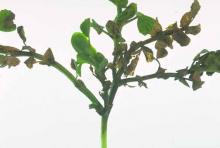Cause Stem, crown, and foliar diseases of pea are caused by a complex of Phoma medicaginis var. pinodella, Ascochyta pisi, and Mycosphaerella pinodes. Crown rot is caused primarily by P. medicaginis var. pinodella. Upper stem, foliar, and pod blights are caused by A. pisi and M. pinodes. All these pathogens are transmitted by seed, so do not save seed from affected fields. P. medicaginis and M. pinodes can survive long periods in soil as thick-walled chlamydospores. Of the three, M. pinodes is by far the most aggressive and causes the most economic loss. Plants are more susceptible as they mature and are most susceptible from flowering to full maturity.
Symptoms Ascochyta blight can develop on seedlings in cool, wet weather. Stem tissue blackens and dies, beginning at the soil line and extending up the stem 2 to 6 inches. Young plants may die or survive in a weakened condition. Later in the season, severe leaf, stem, and pod spotting can occur with slight to severe losses in yield and quality.
Cultural control
- Rotate out of peas at least 4 years. Do not include vetch or alfalfa in the rotation.
- Use seed from pathogen-free fields; do not save seed from affected fields.
- Burn or plow under diseased pea straw after harvest.
- Plant midseason to late-maturing varieties, or wait until warm weather to plant. Sometimes a 2-week delay in planting results in significantly less disease.
Chemical control If using nitrogen-fixing inoculants, add twice the amount of rhizobia inoculant and put inoculant in the seed furrow, not on seed; or add inoculum no more than 2 hours before planting.
- Seed treatments:
- Captan 4F (Group M4) at 2.6 fl oz/100 lb seed plus a dye.
- Mertect 340-F (Group 1) at 1.02 fl oz/100 lb seed plus a dye. 12-hr reentry.
- 42-S Thiram (Group M3) at 3 fl oz/100 lb seed plus a dye. See label for reentry restrictions.
- Rovral 4 Flowable (Group 2) at 5.6 oz/100 lb seed plus a dye in Washington (SLN WA-930026) and Idaho (SLN ID-930015) only for pea seed exported to Sweden. See label for reentry restrictions.
- Wakil XL (Group 12 + 4 + 27) at 3.2 oz/100 lb seed, plus a dye. For pea seed exports from Washington only (SLN WA-000037). 48-hr reentry.
- Affiance (Group 3 + 11) at 10 to 19 fl oz/A on 14- to 21-day intervals. Preharvest interval is 14 days. 12-hr reentry.
- Aprovia Top (Group 7 + 3) at 10.5 to 11 fl oz/A on 7- to 14-day intervals for dried shelled pea only. Do not apply more than two (2) sequential applications or two (2) application per year. Preharvest interval is 14 days. 12-hr reentry.
- Cueva (Group M1) at 0.5 to 2 gal/100 gal water on 7- to 10-day intervals. May be applied on the day of harvest. Poor control as a stand-alone product. 4-hr reentry. O
- Endura (Group 7) at 6 oz/A for dried peas and 8 to 11 oz/A for succulent peas on 5- to 14-day intervals. Do not feed treated pea commodities to livestock. Studies out of ND showed Endura to not be very effective on this pathogen complex. Preharvest interval is 21 days for dried peas and 7 days for succulent peas. 12-hr reentry.
- OSO 5% SC (Group 19) at 3.75 to 13 fl oz/A on 7- to 14-day intervals. Can be applied the day of harvest. 4-hr reentry O.
- Priaxor Xemium Brand (Group 7 + 11) at 6 to 8 fl oz/A. Do not make more than one (1) application of any Group 11 fungicide before alternating to a labeled fungicide with a different mode of action. Studies out of ND showed Priaxor Xemium to be very effective on this pathogen complex. Preharvest interval is 7 days for fresh peas, 14 days for pea hay, and 21 days for field peas. 12-hr reentry.
- Proline 480 SC (Group 3) is labeled for dried, shelled peas at 5.7 fl oz/A on 5- to 14-day intervals for up to three (3) applications per year. Studies out of ND showed Proline to be very effective on this pathogen complex. Preharvest interval is 7 days. 12-hr reentry.
- Strobilurin fungicides (Group 11) are labeled for use. Do not make more than one (1) application of any Group 11 fungicide before alternating to a labeled fungicide with a different mode of action. Studies out of ND showed Group 11 fungicides to be moderately to very effective on this pathogen complex. Best used with a tank-mix fungicide partner or in rotations.
- Aproach at 6 to 12 fl oz/A prior to disease development on 7- to 14-day intervals in dried or field peas. Preharvest interval is 14 days for pods, 0 day for forage and hay. 12-hr reentry.
- Headline at 6 to 9 fl oz/A prior to disease development on 7- to 14-day intervals. Preharvest interval is 7 days for pods, 14 days for forage and hay. 12-hr reentry.
- Quadris Flowable at 6 to 15.5 fl oz/A on 7- to 14-day intervals. May be applied the day of harvest on succulent peas. Preharvest interval is 14 days for dry pea seeds. 4-hr reentry.
- Vacres (potassium bicarbonate) at 2.5 to 5 lb/A on 7- to 14-day intervals. Preharvest interval is zero (0) days. 4-hr reentry.
Biological control Efficacy in Oregon unknown.
- Double Nickel LC at 1 to 6 quarts/A on 3- to 10-day intervals. Can be applied the day of harvest. 4-hr reentry. O
Reference Wunsch, M.J., Schaefer, M.D., Kraft, B.J., and Schatz, B.G. 2012. Field evaluation of fungicides to control Mycosphaerella blight on field peas, Carrington, ND, 2011. Plant Disease Management Reports 6:FC095.

